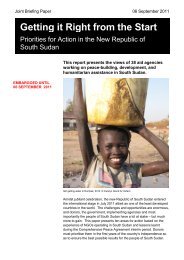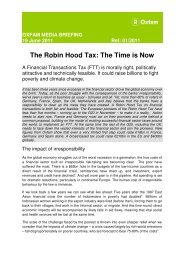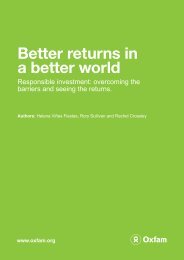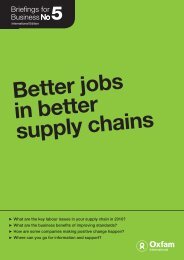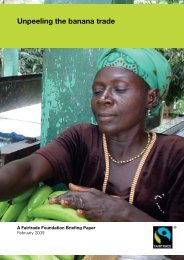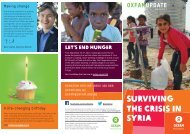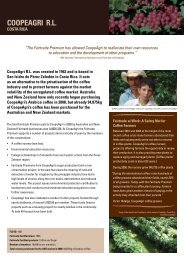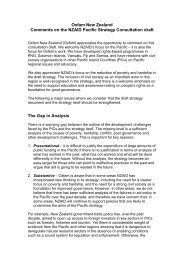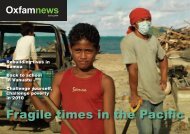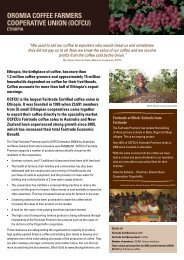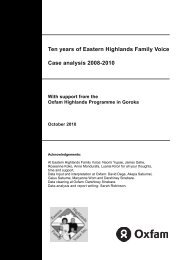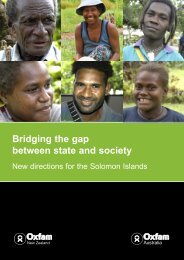Growing a Better Future - Oxfam International
Growing a Better Future - Oxfam International
Growing a Better Future - Oxfam International
- No tags were found...
You also want an ePaper? Increase the reach of your titles
YUMPU automatically turns print PDFs into web optimized ePapers that Google loves.
79 Based on 2007 sales figures in global proprietary seed market,G. Meijerink and M. Danse, (2009) ‘Riding the Wave: HighPrices, Big Business? The role of multinationals in theinternational grain markets’, LEI Wageningen UR.80 Based on Ibisworld, ‘Global Fertilizers and AgriculturalChemicals Manufacturing 10’ (2009), quoted in ‘TNCs and theRight to Food’, paper authored by the Law Students for HumanRights at New York University School of Law, prepared at therequest of the United Nations Special Rapporteur on the Right toFood, 2009. The top six producers are BASF, Bayer, Dow,DuPont, Monsanto, and Syngenta.81 The Brazilian Research Institution EMBRAPA is one of theworld’s largest funders of agricultural R&D with a budget of about$1.1bn. China’s agricultural R&D spend has increased at about10 per cent per annum since 2001, totalling $1.8bn in 2007.82 For background see, M. Hendrickson, J. Wilkinson, W. Heffernanand R. Gronski (2008) ‘The Global Food System and Nodes ofPower’, an analysis prepared for <strong>Oxfam</strong> America, 2008; On the‘modus operandi’, see Etc Group Communique ‘Patenting the“Climate Genes”…And Capturing the Climate Agenda’, availableat http://www.etcgroup.org/en/node/68783 http://www.nature.com/news/2010/100728/full/466548a.html84 US Federal spending on agricultural science in 2007 was $1.1bn.CGIAR’s annual budget is $500m.85 Arcand (2004) in M. Mercoiret and J.M Mfou’ou (2006) ‘RuralProducer Organisations, Empowerment of Farmers and Resultsof Collective Action’, Theme No 1, ‘Rural Producer Organisationsfor Pro-Poor Sustainable Development’, report of the ParisWorkshop, WDR 2008: Agriculture for Development.86 Research by Leuven University cited in GCGF and CIPE (2007)‘Corporate Governance and Co-operatives’, Workshop Report ofPeer Review Workshop, 8 February 2007, London, convened byGlobal Corporate Governance Forum (GCGF) and Centre for<strong>International</strong> Private Enterprise (CIPE).87 IDS (2008) ‘Reforming Land Reform in the Philippines’. Note thatmany issues remain, for example, much of the land so farredistributed has been marginal, and at prices that many believehave been too high.88 http://www.oxfamblogs.org/fp2p/?s=bogota&x=44&y=1089 D. Green (2008) From Poverty to Power, p.31, p.146.90 Von Braun (2008) op. cit. See http://www.ifpri.org/sites/default/files/publications/pr20.pdf91 FAO (2008) ‘Crop Prospect and Food Situation’92 World Bank, http://web.worldbank.org/WBSITE/EXTERNAL/NEWS/0,,contentMDK:21827681~pagePK:64257043~piPK:437376~theSitePK:4607,00.html93 Ivanic and Martin (2008) ‘The Implications of Higher Global FoodPrices for Poverty in Low-Income Countries’, World Bank PolicyResearch Working Papers.94 http://www.ids.ac.uk/index.cfm?objectid=7BEEE2E6-E888-1C81-4222828ABE71B95A95 Giminez and Patel (2009), Food Rebellions, Pambazuka Press,p18.96 Javier Blas, ‘Tackle Export Bans to Ease Food Crisis’, FinancialTimes 3 February 2011.97 In 2011, Cargill is heading for its best year yet on the back of cropdisruptions and price volatility. ‘Cargill posted solid earnings in aperiod of volatile commodity markets and geopolitical change,’said Greg Page, chairman and chief executive. Gregory Meyer,‘Cargill Set for Record Yearly Profit’, Financial Times, 13 April2011, see http://www.ft.com/cms/s/0/0c0ee826-65d5-11e0-baee-00144feab49a.html#axzz1JYtZYouV)98 Gregory Meyer, ‘Bunge Rides on Volatility of Food Markets’,Financial Times, 28 December 2010, see http://www.ft.com/cms/s/0/89e80c8a-12a8-11e0-b4c8-00144feabdc0.html#axzz1JbmlzZxQ99 One example is the Alliance for Abundant Food and Energy,founded by ADM, Monsanto, and the Renewable FuelsAssociation in the USA.100 http://www.fao.org/es/ESC/common/ecg/584/en/Panel_Discussion_paper_2_English_only.pdf101 Lester Brown (2011) ‘World on the Edge: How to PreventEnvironmental and Economic Collapse’, Earth Policy Institute.102 Ibid.103 World Bank (2008) ‘Double Jeopardy: Responding to High Foodand Fuel Prices’, paper prepared for G8 Hokkaido-ToyakoSummit, 2 July 2008. See http://goo.gl/BhRWa104 http://www.ifpri.org/sites/default/files/publications/rr165.pdf105 http://www.ft.com/cms/s/0/a2aa510a-1e89-11e0-87d2-00144feab49a.html#axzz1CFL7EYl1106 F. Kaufman (2010) ‘The food bubble: how Wall Street starvedmillions and got away with it’, Harper’s Magazine, 32, July 2010.107 See, for instance, FAO (2010) ‘Final Report of the Committee onCommodity Problems: Extraordinary Joint IntersessionalMeeting of the Intergovernmental Group (IGG) on Grains and theIntergovernmental Group on Rice’; O. de Schutter (UN SpecialRapporteur on the Right to Food) (2010) ‘Food CommoditiesSpeculation and Food Price Crises: Regulation to Reduce theRisks of Financial Volatility; C. Gilbert (Trento University) (2010)‘How to Understand High Food Prices’, Journal of AgriculturalEconomics; or World Bank (2010) ‘Placing the 2006/2008Commodity Price Boom into Perspective’.108 UN Office for the Coordination of Humanitarian Affairs’ FinancialTracking Service. The data are posted at http://fts.unocha.org/pageloader.aspx?page=home109 A. Evans (2010) ‘Globalization and Scarcity: Multilateralism for aWorld with Limits’, NYU Center on <strong>International</strong> Cooperation.Available at http://www.cic.nyu.edu/scarcity/docs/evans_multilateral_scarcity.pdf110 The World Food Programme’s (WFP) current emergencyoperations are only 65 per cent funded, while its operations inmore protracted hunger situations are less than half funded.WFP, ‘Resource Situation Summary’, 27 February 2011,Summary Chart of Confirmed Contributions to EmergencyOperations (EMOPS), http://documents.wfp.org/stellent/groups/public/documents/research/wfp229123.pdf.WFP, ResourceSituation Summary, 27 February 2011, Summary Chart ofConfirmed Contributions to Protracted Relief Operations(PRROs), http://documents.wfp.org/stellent/groups/public/documents/research/wfp228935.pdf111 WFP INTERFAIS Reporting System (measures of food in metrictons), 1988–2009. Report generated on 18 April 2011, http://www.wfp.org/fais/reports/quantities-delivered-report/run/year/2009;2008;2007;2006;2005;2004;2003;2002;2001;2000;1999;1998;1997;1996;1995;1994;1993;1992;1991;1990;1989;1988/donor/All/mode/All/cat/All/recipient/All/code/All/basis/0/subtotal/0/112 WFP INTERFAIS Reporting System (measures of food in metrictons), 1988–2009. Report generated on 18 April 2011, http://www.wfp.org/fais/reports/quantities-delivered-report/run/year/2009;2008;2007;2006;2005;2004;2003;2002;2001;2000;1999;1998;1997;1996;1995;1994;1993;1992;1991;1990;1989;1988/donor/United+States+of+America/mode/All/cat/All/recipient/All/code/All/basis/0/subtotal/0/70



